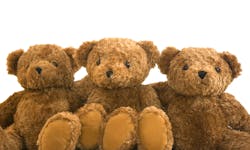Fairy tales feature challenges for their protagonists, and they often end with predictable and obvious outcomes. Optical network planners, however, can only wish they could solve their challenges so conveniently.
But all is not lost. Fairy tales also use the plot device of a beneficent spirit such as a fairy godmother to turn things around for the hero. Optical vendors, in their quest for smaller, faster, and cheaper technology, have unlocked their own plot device in the form of coherent pluggables. With their 400G bit rates and small form factors, these standardized, interoperable modules offer plenty of intrigue to the tale.
But there’s a catch. Just as Goldilocks faced a series of decisions to select which option was just right for her, so too do optical network planners. And for them, the decision they face is a lot more complex than which bowl of porridge is best.
Certainly pluggable optics have a role to play for short single spans in data center interconnect (DCI) networks. But where else does it make sense to deploy them? Can their promising benefits be leveraged in metro and regional networks as well? Or does it make sense to continue using discrete optics?
In this article, we examine both the well-known and the more recently discovered pros and cons of pluggable and discrete coherent optics, to help chop through the forest of thorns and get to the right decision for your network.
Our tale of 400G pluggables begins with 400ZR. As has been well documented elsewhere, 400ZR pluggables deliver three benefits beyond the cost-effective simplicity of IP over WDM gained by installing a pluggable directly into a router:
- Lower opex by reducing power consumption, physical size, and feature set
- Match the 400 Gigabit Ethernet (GbE) client interfaces and 400G line-side interfaces
- Enable more competition, flexible supply chains, and best-in-breed technology via an open, interoperable standard.
Unlike traditional transponders, 400ZR pluggables do not require their own management systems because they are managed via the router. This characteristic, combined with their limited feature set, lower power consumption, lower performance, and overall competitiveness, makes it possible to reduce costs significantly. Obviously, 400ZR pluggables are a good solution for DCI networks that frequently use direct spans over short distances and therefore can get by with lower launch power. But what to do if greater reach is still needed?
Extend Reach with ZR+—At a Price
To extend reach, vendors use higher launch power. The big advantage of ZR+ pluggables is to allow proprietary forward error correction (FEC), enabling greater performance and further reach. Since vendors keep optical specification details such as net coding gain from FEC and optical signal-to-noise ratio (OSNR) tolerance confidential, most planning tools are not capable of accurately estimating reach. To compensate, they must assume a high margin of error in their link planning, thereby reducing reach. So, the proprietary nature of ZR+ not only compels service providers to surrender flexibility by bookending the pluggables, it typically also locks them in to a single vendor whose network planning tool is programmed with the proprietary information for both transponder and line system.
With the greater reach of ZR+, as well as the ability to support multiple client and line rates, service providers hoped to find other applications to take advantage of these small, lower-cost pluggables. To understand the adaptations needed for pluggables to be deployed more broadly in service provider networks, it may help to first compare some common traits of DCI and metro networks.
Contrasting DCI and Metro Network Architectures
While DCI networks often use short-distance direct connections, metro networks are more complex. With a much wider range of A-Z endpoints, metro networks often rely on a mesh architecture consisting of many ROADMs that may cover both short and long distances. As a result, many metro circuits require higher-performance optics that can scale across multiple dimensions to meet reach and capacity requirements.
Unlike DCI networks, metro networks that offer services to enterprises require a clear point of demarcation between service provider and enterprise. This is to delineate responsibility for tasks such as installation, power, management, control, security, maintenance, and troubleshooting. However, this clear demarcation is not feasible with a router-attached pluggable physically installed in and managed through an enterprise’s router.
Metro networks often need to support OTN client signals in addition to Gigabit Ethernet. Additionally, unlike many data centers, the locations where metro equipment is typically deployed must meet NEBS3 compliance, a statute that requires hardware to endure tough, variable physical conditions.
Considerations for Deploying Pluggables in Metro Networks
While service providers are rightly excited about the benefits pluggables can bring, they also pose a few challenges for planners to consider:
- Increased inter-channel interference and lower OSNR resulting from the lack of some advanced shaping techniques
- Reduced spectral efficiency resulting from greater channel widths
- External amplification to compensate for lower launch power.
With limited real estate and lower power on the QSFP-DD and OSFP pluggables, it is not possible to include some advanced shaping techniques. In contrast, discrete optical alternatives can produce superior signal shaping to offer superior signal strength, lower inter-channel interference, and therefore higher OSNR to achieve greater reach/capacity.
Although the signal strength cannot easily be improved without correspondingly increasing noise, service providers can reduce inter-channel interference by increasing the channel width. However, this will result in worse spectral efficiency than that achievable with a discrete optical approach. Thus, service providers with limited fiber should weigh the benefits of using a 400ZR or ZR+ pluggable against the disadvantage of spectral inefficiency.
In addition, while pluggables consume less power, their lower launch power may be insufficient to transit the longer circuits in metro or regional networks on their own. To compensate, external amplifiers can be deployed to boost the launch power. However, doing so will not only reduce or even cancel out the power and space savings from pluggables, but will also increase noise even further.
Given their much smaller size, one benefit of pluggables is the potential to save space by packing them together. However, planners must also consider the heat generated by densely packed pluggables; maintaining adequate thermal dissipation often requires equipment to be spread farther apart anyway.
Considerations for Deploying Discrete Optics with a Full Feature Set
While pluggables certainly offer many advantages, several applications will continue to require traditional transponders with discrete optics. The benefits of traditional transponders include:
- Higher launch power and better shaping for lower OSNR and greater reach
- Better spectral efficiency
- Ability to transit more ROADMs
- Both OTU and variable rate Gigabit Ethernet interfaces
- NEBS compliance
- Clear demarcation between service provider and enterprise
- Straightforward coexistence with existing service provider metro networks.
Often overlooked is the fact that transponders with discrete optics will also continue to offer a complete feature set. For example, router-attached QSFP-DD and OSFP pluggables lack the real estate to support several features service providers are accustomed to:
- Loopback testing
- Regeneration (without consuming additional client ports)
- Layer 1 encryption
- 400G demux (2 x 200G wavelengths)
- System-level functions.
The Best of Both Worlds with Open ROADM
Given the relative merits of the choices, an option that provided the best of both worlds would be very attractive. In actuality, it is possible to combine the best of discrete optics with the advantages of a pluggable form-factor. This combination can be achieved with 400G Open ROADM.
Not only does 400G Open ROADM support both GbE and OTN interfaces, it also uses open FEC (oFEC) that is superior to the concatenated FEC (cFEC) used in 400ZR. Importantly, Open ROADM uses larger CFP2-DCO pluggables designed for transponders. With much more space to work with, a full feature set including capabilities like loopback testing is available, along with most of the other benefits of the traditional type of transponder described in the previous section about discrete optics. Nevertheless, it is true that 400G Open ROADM pluggables require more power and space than QSFP-DD or OSFP pluggables. But they still benefit from complete interchangeability between vendors, ensuring best-of-breed architectures at a competitive price.
Taking the Next Step with OpenZR+
Many service providers and data center network operators like the standardized interoperable solutions of 400ZR and Open ROADM that avoid vendor lock-in and encourage innovation. They also value the superior reach of Open ROADM’s oFEC and its flexibility with variable bit rates. Some operators, however, preferred the lower power of 400ZR and had no need for OTN clients. The OpenZR+ MSA was created to blend the two. OpenZR+ can be implemented on the smaller QSFP-DD and OSFP modules for router-attached deployments targeted at long-haul DCI networks. Alternatively, they can be implemented on larger CFP2-DCO modules for transponder-attached implementations targeted at regional and metro service provider networks.
As long as OpenZR+ is implemented on the larger CFP2-DCO pluggable and attached to a transponder, service providers can take advantage of higher power with a more complete feature set while maintaining clear demarcation between their network and their enterprise clients.
Earlier, we noted that multivendor networks required more sophisticated network management and control systems. Fortunately, new cutting-edge multivendor planning tools are being introduced that use artificial intelligence to empirically measure performance in a variety of configurations and use this information to predict the performance of new transponders whether they are discrete or pluggable.
Determining Which Solution is “Just Right” for Your Network
If your network is composed entirely of short, direct circuits for 400G traffic and you do not need to worry about clear demarcation with a router or whether your optical transport is managed via a router, then fully interoperable, router-attached 400ZR pluggables are probably a good, economical choice. If you need more distance and can sacrifice the advantages of lower power, density, and interoperability, then proprietary ZR+ implementations may be better.
On the other hand, if you need OTN client signals (OTU4), higher launch power, spectral efficiency, a full feature set, and/or clear demarcation, then fully interoperable and competitive transponder-attached 400G Open ROADM pluggables may be just right. If you do not need OTU4 interfaces and prefer to reduce power costs, OpenZR+ may be a good compromise.
Of course, the highest performance and most feature-rich option capable of transiting the most ROADMs will continue to be traditional transponders with discrete optics. For smaller locations, it is helpful to have a flexible optical platform that can support both pluggable and discrete options. With multiple options under the same roof, Goldilocks was consistently able to find the solution that was just right. The same holds true for optical network planners.
Rob Hughes is optical networks solution leader at Fujitsu.
About the Author
Rob Hughes
optical networks solution leader, Fujitsu
Rob Hughes is optical networks solution leader at Fujitsu.

